SUMMARY OF FINDINGS
INTRODUCTION
This publication presents statistics relating to the criminal jurisdiction of the Higher (Supreme and Intermediate) and Magistrates' Courts of Australia, for the period 1 July 2005 - 30 June 2006. Experimental data are also available for Children's Courts in Appendix 1. The criminal jurisdiction of the courts includes the trial and sentencing of persons and organisations charged with criminal offences. The statistics are based on data extracted from administrative records held by state and territory agencies responsible for courts administration. Data are supplied to the ABS by the courts administering agency for all states and territories except for Queensland (where they are supplied via the Office of Economic and Statistical Research), and New South Wales (where they are supplied via the Bureau of Crime Statistics and Research).
The publication provides a picture of the characteristics of defendants dealt with by the Higher, Magistrates' and Children's Courts of Australia, including information on the offences and sentence types associated with those defendants.
There are significant differences between the states and territories in the way the Higher Courts and Magistrates' Courts systems are structured and how criminal cases are allocated between court levels. For example, legislation differs between states and territories regarding which offence types can be heard summarily in the Magistrates' Courts and which offence types must be indicted to a Higher Court. Caution should therefore be taken when making comparisons between states and territories.
Data collected in 2004-05 has been revised for Queensland, Northern Territory and Australia. The impacts of these revisions on 2004-05 populations are described in paragraphs 48-52 and 56 of the Explanatory Notes.
The Explanatory Notes provide detailed information on the data sources, definitions, counting rules and other technical matters associated with this publication.
For ease of reading, 'most serious offence/charge' is referred to as 'offence/charge' throughout this publication. The term 'related offences' has also been omitted for ease of reading for the following offence/charges: homicide and related offences; sexual assault and related offences; robbery, extortion and related offences; and deception and related offences.
CHARACTERISTICS OF DEFENDANTS
Summary
In 2005-06, there were 586,202 defendants finalised in the Higher and Magistrates' Courts in Australia, an increase of 2% (10,774) on the number of defendants finalised in 2004-05. Of defendants finalised in 2005-06, 3% (16,319) were finalised in the Higher Courts and 97% (569,883) were finalised in the Magistrates' Courts.
Higher Courts
The number of defendants finalised in the Higher Courts decreased by 4% from 16,964 in 2004-05 to 16,319 in 2005-06.
Of those defendants finalised in the Higher Courts, 87% (14,163) were adjudicated, meaning that the court made a determination of the defendant's guilt or innocence of the offence(s) with which they were charged. The remaining 13% (2,156) were finalised by non-adjudicated methods, in which there is no determination of the charges by the court. This includes outcomes such as all charges being withdrawn by the prosecution.
DEFENDANTS FINALISED(a), HIGHER COURTS
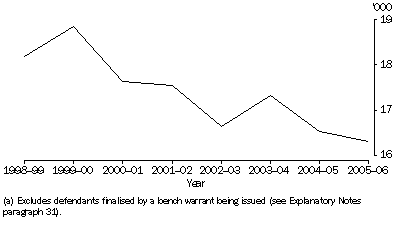
Magistrates' Courts
The number of defendants finalised in the Magistrates' Courts increased by 2% from 558,464 in 2004-05 to 569,883 in 2005-06. Between 2003-04 and 2005-06 the number of defendants finalised in the Magistrates' Courts increased by 8%.
Of those defendants finalised in the Magistrates' Courts 90% (510,069) were adjudicated. The remaining 10% (59,813) were finalised by non-adjudicated methods such as all charges withdrawn by the prosecution or transfer to another court level.
DEFENDANTS FINALISED, MAGISTRATES' COURTS
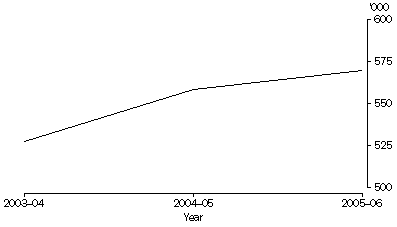
DEFENDANTS ADJUDICATED
Higher Courts
In 2005-06, 9% (1,249) of defendants adjudicated were acquitted and 91% (12,914) proven guilty. Of those defendants proven guilty, 88% (11,354) pleaded guilty and 12% (1,560) were found guilty following a trial.
Principal offence
Offence refers to the principal offence adjudicated by the court for each defendant (refer to paragraphs 40-43 of the Explanatory Notes).
Five offence types accounted for 73% of defendants adjudicated in the Higher Courts: acts intended to cause injury (23%); illicit drug offences (17%); sexual assault (14%); robbery (10%); and unlawful entry with intent (10%). Between 2001-02 and 2005-06, these five offences have accounted for the largest number of defendants adjudicated.
Although the total number of defendants adjudicated has decreased 7% since 2001-02, the number of defendants adjudicated has increased for those with an offence of illicit drugs or sexual assault (19% and 21% respectively). The number of defendants adjudicated for the offences of robbery and unlawful entry with intent have decreased between 2001-02 and 2005-06 (27% and 38% respectively).
DEFENDANTS ADJUDICATED (a), HIGHER COURTS, Selected principle offences by year
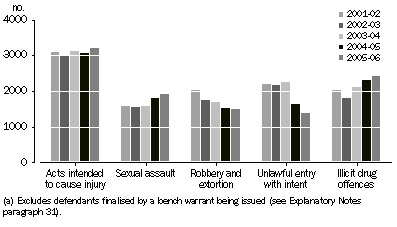
Between 2004-05 and 2005-06, the offence categories with the largest percentage decrease were theft (decrease of 26% to 481) and deception (decrease of 23% to 795). These two offences decreased in every state and territory.
Principal offence - Sex
In 2005-06, defendants adjudicated were more likely to be male (88%) than female (12%). The three offences for which male defendants were most likely to be adjudicated are acts intended to cause injury (22%); illicit drug offences (17%); and sexual assault (15%). The three offences for which female defendants were most likely to be adjudicated are acts intended to cause injury (24%); illicit drug offences (19%); and deception (14%).
DEFENDANTS ADJUDICATED, HIGHER COURTS, Selected principal offences by sex
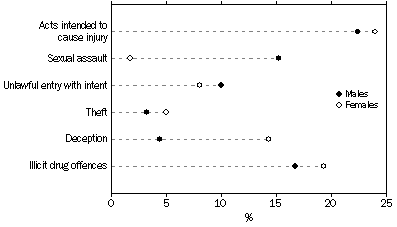
Principal offence - Age
Those aged between 25 and 34 years (32%) were most likely to be adjudicated, followed by people aged under 24 years (30%), and those aged between 35 and 44 years (22%). People aged 45 years and over represented 16% of defendants adjudicated.
Where defendants were adjudicated for the offences of acts intended to cause injury, robbery and extortion, and theft, the highest proportion of defendants were 24 years or under. Of those adjudicated for unlawful entry with intent and illicit drug offences, the highest proportion of defendants were aged between 25 and 34 years. For the offence of sexual assault 34% of defendants were aged 45 years and over.
DEFENDANTS ADJUDICATED, HIGHER COURTS, Selected principal offences by selected age groups
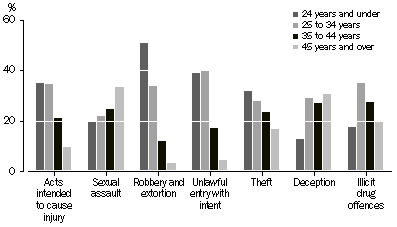
Magistrates' Courts
Of defendants adjudicated in the Magistrates' Courts 73% were adjudicated with a guilty plea, 8% with a guilty finding, 15% with guilty ex-parte and 4% were acquitted.
Principal Offence
Road traffic and motor vehicle regulatory offences accounted for the highest proportion (44%) of defendants adjudicated in Magistrates' Courts in Australia. This was followed by public order offences (10%); dangerous or negligent acts endangering persons (8%); acts intended to cause injury (7%); theft and offences against justice procedures (both 6%).
Principal Offence - Sex
In 2005-06, defendants adjudicated were more likely to be male (79%) than female (21%). Excluding road traffic and motor vehicle regulatory offences, the three offences for which male defendants were more likely to be adjudicated are public order offences (19%); dangerous or negligent acts endangering persons (15%); and acts intended to cause injury (14%). The three offences for which female defendants were more likely to be adjudicated, excluding road traffic and motor vehicle regulatory offences, are theft (19%); public order offences (14%); and dangerous or negligent acts endangering persons (13%).
DEFENDANTS ADJUDICATED, MAGISTRATES' COURTS(a), Selected principal offences by sex
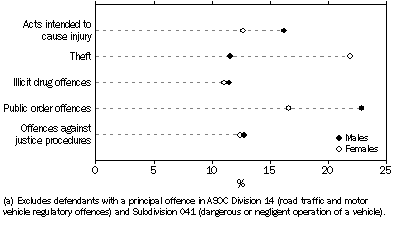
Principal Offence - Age
The largest number of defendants adjudicated in the Magistrates' Courts were aged 24 years or under, followed by those aged 25 to 34 years, 35 to 44 years, and 45 years and over.
People aged 24 years and under were the highest proportion of defendants adjudicated for unlawful entry with intent; public order offences; dangerous or negligent acts and theft. Those aged 25 to 34 years were the highest proportion of defendants adjudicated for acts intended to cause injury; deception and illicit drugs.
Defendants aged 45 years and over were more likely to have been adjudicated for road traffic offences (52%) than defendants aged 24 years and under (40%), and less likely to have been adjudicated for a public order offence (7%) than those aged 24 years and under (13%).
DEFENDANTS ADJUDICATED, MAGISTRATES' COURTS(a), Selected principal offences by selected age groups
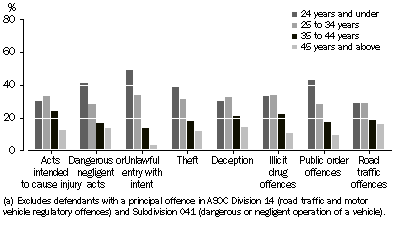
PRINCIPAL OFFENCE - ADJUDICATION TYPE
Higher Courts
Nationally 91% of defendants adjudicated in the Higher Courts were proven guilty. Defendants adjudicated with public order offences in the Higher Courts, were most likely to be proven guilty (98%), whilst defendants adjudicated with a principle offence of sexual assault (77%) and homicide (78%) had a lower rate of proven guilty outcomes.
In the Higher Courts, 80% of defendants adjudicated were finalised by pleading guilty and 20% were finalised by a trial outcome (acquittal or found guilty). Defendants adjudicated with a principal offence of weapons and explosives offences (92%), unlawful entry with intent (89%) or deception (88%) were more likely to be finalised with a guilty plea than for homicide (50%) and sexual assault (60%).
Of the 2,809 defendants adjudicated that had a trial outcome in the Higher Courts, 44% were acquitted. Three principal offences accounted for the majority of trial outcomes; sexual assault offences (27%); acts intended to cause injury (20%); and illicit drug offences (12%). Defendants with a principal offence of sexual assault or acts intended to cause injury were more likely to be acquitted at trial (58% and 47% respectively), whilst defendants with a principal offence of illicit drug offences were less likely to be acquitted (22%).
Magistrates' Courts
In Magistrates' Courts, 96% of defendants adjudicated were proven guilty. For illicit drug offences, weapons and explosives offences and dangerous or negligent acts, 99% of defendants adjudicated were proven guilty.
PRINCIPAL SENTENCE
Data on sentences are collected and published for all defendants that are proven guilty of one or more charges in a criminal court. Sentence refers to the principal sentence a defendant received (refer to paragraph 44 of the Explanatory Notes for further information).
Higher Courts
The majority of defendants proven guilty in the Higher Courts in 2005-06 received a sentence of a custodial order with 82% (10,600) receiving custody in a correctional institution, custody in the community or fully suspended sentences. This proportion has consistently increased over the last 5 years, from 72% in 2001-02.
Of those defendants proven guilty the highest proportion of custodial orders were for defendants that had principal offences of homicide (99%), robbery (92%) and sexual assault (89%).
Defendants proven guilty in the Higher Courts were more likely to have received a custodial sentence in a correctional institution or the community than those found guilty in the Magistrates' Court (61% and 5% respectively). However there were a much larger number of defendants sentenced to custody in a correctional institution or the community by the Magistrates' Courts than the Higher Courts (23,543 and 7,819 respectively).
The proportion of defendants proven guilty in the Higher Courts that received a custodial sentence in a correctional institution or the community ranged from 41% for offences against justice procedures to 57% for illicit drug offences and 90% for homicide.
The proportion of defendants proven guilty in the Higher Courts that received a custodial sentence in a correctional institution or the community also varied across states and territories, ranging from 32% in the Australian Capital Territory to 73% in New South Wales.
DEFENDANTS PROVEN GUILTY, HIGHER COURTS, Selected principal sentences by states and territories
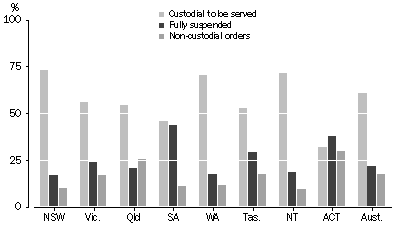
Principal sentence - Age and sex
In the Higher Courts, males proven guilty (62%) were more likely than females (48%) to receive a principal sentence of custody in a correctional institution/community for all principal offences. Females proven guilty (27%) were more likely than males (21%) to receive a fully suspended sentence.
Magistrates' Courts
In the Magistrates' Courts, the largest number of defendants proven guilty that received a custodial sentence in a correctional institution or the community or a fully suspended sentence had principal offences of road traffic and motor vehicle regulatory offence (10,459); acts intended to cause injury (8,597); and theft (5,628).
Defendants with a principal sentence of non-custodial orders (community supervision/work orders, monetary orders and other non-custodial sentences) accounted for 17% of defendants proven guilty in the Higher Courts, while for the Magistrates' Courts the majority (91%) of defendants proven guilty received this type of sentence.
The most common non-custodial orders in the Magistrates' Courts were monetary orders, with 71% of defendants proven guilty receiving this sentence type as their principal sentence. Monetary orders were most common for principal offences of dangerous or negligent acts endangering persons (85% of defendants proven guilty) and road traffic and motor vehicle regulatory offences (84%).
Principal sentence - Age and sex
In the Magistrates' Courts 71% of both males and females proven guilty received a monetary order sentence, whilst 6% of males and 2% of females received a sentence of custody in a correctional institution/community.
Males proven guilty, aged 30-34 years were more likely to receive a custodial sentence in a correctional institution or the community than other age cohorts in the Magistrates' Courts (8%).
DURATION FROM INITIATION TO FINALISATION
The nature of the charges presented to the court, along with the process required to deal with the charges (which is affected by the type of plea), impact on the time required for a court to finalise a case.
Higher Courts
In the Higher Courts, 32% of defendants adjudicated were finalised within 13 weeks from initiation while over half (55%) were finalised within 26 weeks from initiation. Comparatively, in 2004-05, 39% of defendants adjudicated were finalised within 13 weeks and 61% were finalised within 26 weeks.
Of finalised defendants that went to trial and were found guilty by the court, over half (55%) were finalised 52 weeks or more after initiation. Of those acquitted, 43% were finalised within this same period. For defendants finalised by a guilty plea in 2005-06, 38% were finalised in less than 13 weeks compared to 30% in 2004-05.
Unlawful entry with intent (41%) and deception (39%) were the offences with the highest proportion of adjudicated defendants finalised under 13 weeks.
DEFENDANTS FINALISED, HIGHER COURTS 2005-06, Duration from initiation to finalisation by selected principal offences
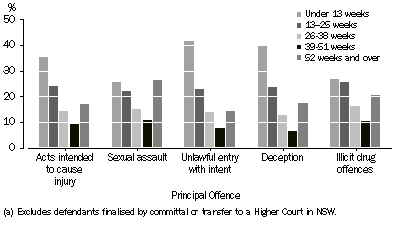
Magistrates' Courts
Defendants finalised in the Magistrates' Courts are generally finalised in a shorter amount of time than those finalised in the Higher Courts. In the Magistrates' Courts, 56% of defendants were finalised within 6 weeks of initiation. Public order offences (79%), dangerous or negligent acts endangering persons (69%) and illicit drug offences (63%) were the principal offences with the highest proportion of defendants that were finalised within 6 weeks of initiation in 2005-06.
DEFENDANTS FINALISED, MAGISTRATES' COURTS 2005-06, Duration from initiation to finalisation
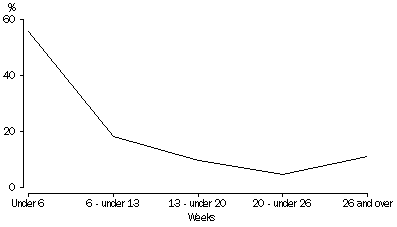
CHILDREN'S COURTS
The Children's Courts data are provided on an experimental basis for 2005-06. A summary of the main characteristics of defendants finalised in the Children's Courts, including information on the offences and sentences associated with these defendants, can be found in Appendix 1.
 Print Page
Print Page
 Print All
Print All